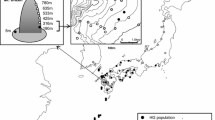Abstract
Between the two subsocial spider mites, Schizotetranychus longus Saito and S. miscanthi Saito, a big difference exists in male reproductive behavior. The males of the former species have an extraordinarily mild relationship with conspecific males, whereas those of the latter species show mortal aggression against conspecific males. Field and experimental observations on the structure of mating populations showed that S. longus is under inbreeding conditions because of a lack of males in early spring, whereas S. miscanthi is under outbreeding conditions. Therefore, I hypothesized that the difference in male antagonism between the two species may reflect the difference in relatedness of males, that is, it has evolved by kin selection. The recent discovery of two clinal trends in male–male aggression in S. miscanthi provided evidence in favour of this hypothesis. Furthermore, a correlation analyses between experimentally evaluated male aggression and distribution patterns of males in the field indicated that the variation in male antagonism is actually reflected in field populations. Based on these studies, I discuss the solidity of the kin-selection hypothesis. Lastly I address how spider mites are fruitful model animals for conducting behavioral, ecological and genetic studies to understand the evolution of haplo-diploidy.
Similar content being viewed by others
References
Crozier, R.H. 1985. Adaptive consequences of male-haploidy. In: Spider mites, their biology, natural enemies and control, W. Helle and M.W. Sabelis (eds), Vol. 1A, pp. 201–222, Elsevier, Amsterdam.
Darwin, C.R. 1871. The Descent of Man and Selection in Relation to Sex. Vols. 1and 2, Appleton, New York.
Ehara, S. 1999. Revision of the spider mite family Tetranychidae of Japan (Acari, Prostigmata). Species Diversity 4: 63–141.
Hamilton, W.D. 1964. The genetical evolution of social behaviour I & II. J. Theor. Biol. 7: 1–52.
Hamilton, W.D. 1972. Altruism and related phenomena, mainly in social insects. Annu. Rev. Ecol. Syst. 3: 193–232.
Hamilton, W.D. 1979. Wingless and fighting males in fig wasps and other insects. In: Sexual selection and reproductive competition in insects, M.S. Blum and N.A. Blume (eds), pp. 167–220, Academic Press, New York.
Harvey, P.H. and Pagel, M.D. 1991. The Comparative Method in Evolutionary Biology. Oxford University Press, Oxford.
Ims, R.A. and Yoccoz, N.G. 1997. Studying transfer processes in metapopulations, emigration, migration, and colonization. In: Metapopulation biology, ecology, genetics, and evolution, I. Hanski and M.E. Gilpin (eds), pp. 247–265, Academic Press, San Diego.
Iwao, S. 1968. A new regression method for analyzing the aggregation pattern in animal populations. Res. Popul. Ecol. 10: 1–20.
Potter, D.A., Wrensch, D.L. and Johnston, D.E. 1976. Guarding, aggressive behavior, and mating success in male two-spotted spider mites. Ann. Entomol. Soc. Am. 69: 707–711.
Saito, Y. 1983. The concept of 'life types' in Tetranychidae. An attempt to classify the spinning behaviour of Tetranychinae. Acarologia 24: 377–391.
Saito, Y. 1986a. Biparental defense in a spider mite (Acari, Tetranychidae) infesting Sasa bamboo. Behav. Ecol. Sociobiol. 18: 377–386.
Saito, Y. 1986b. Prey kills predator: counterattack success of a spider mite against its specific phytoseiid predator. Exp. Appl. Acarol. 2: 47–62.
Saito, Y. 1987. Extraordinary effects of fertilization status on the reproduction of an arrhenotokous and sub-social spider mite (Acari: Tetranychidae). Res. Popul. Ecol. 29: 57–71.
Saito, Y. 1990a. Two new spider mite species of the Schizotetranychus celarius complex (Acari: Tetranychidae). Appl. Entomol. Zool. 25: 389–396.
Saito, Y. 1990b. 'Harem' and 'non-harem' type mating systems in two species of subsocial spider mites (Acari, Tetranychidae). Res. Popul. Ecol. 39: 263–278.
Saito, Y. 1994a. Do males of Schizotetranychus miscanthi (Acari, Tetranychidae) recognize kin in male competition? J. Ethol. 12: 15–18.
Saito, Y. 1994b. Is sterility by deleterious recessives an origin of inequalities in the evolution of eusociality? J. Theor. Biol. 166: 113–115.
Saito, Y. 1995. Clinal variation in male-male antagonism and weaponry in a subsocial mite. Evolution 49: 413–417.
Saito, Y. 1997. Sociality and kin selection in Acari. In: The evolution of social behaviour in insects and arachnids, J.C. Choe and B.J. Crespi (eds), pp. 443–457, Cambridge University Press, London.
Saito Y. and Sahara, K. 1999. Two clinal trends in male-male aggression in a subsocial spider mite. Behav. Ecol. Sociobiol. 46: 25–29.
Sato, Y., Saito, Y. and Mori, K. 2000. Reproductive isolation between populations showing different aggression in a subsocial spider mite, Schiozotetranychus miscanthi Saito (Tetranychidae: Acari). Appl. Ent. Zool. 35(in press).
Shellman-Reeve, J.S. 1997. The spectrum of eusociality in termites. In: The evolution of social behaviour in insects and arachnids, J.C. Choe and B.J. Crespi (eds), pp. 52–93, Cambridge University Press, London.
Veerman, A. 1985. Diapause. In: Spider mites, their biology, natural enemies and control, W. Helle and M.W. Sabelis (eds), Vol. 1A, pp. 279–310, Elsevier, Amsterdam.
Wilson, E.O. 1975. Sociobiology-The New Synthesis. Belknap Press of Harvard University Press, Cambridge.
Author information
Authors and Affiliations
Rights and permissions
About this article
Cite this article
Saito, Y. Do Kin Selection and Intra-Sexual Selection Operate in Spider Mites?. Exp Appl Acarol 24, 351–363 (2000). https://doi.org/10.1023/A:1006480520540
Issue Date:
DOI: https://doi.org/10.1023/A:1006480520540




